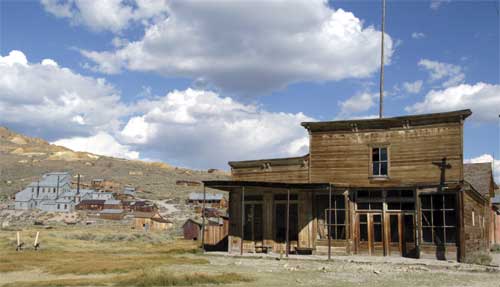|
Leigh
Pringle and Jill Lachman of The
Friends of Bodie contacted us to ask for our reader’s help in
saving
Bodie
State
Historic
Park
. Jill fills us in on the
current state of affairs with this article.
David Tayres has
more information on how you can help and where you can send money to
help stabilize some of the more deteriorating buildings on his website
www.bodie.com.
We will post updates on how things are going and what more you
can do, as we receive them.
Since the passage of the California Desert Protection Act
(1984) an effort was made to create a coalition of agencies that would
pool their financial resources with the intent to purchase the
property which Galactic Resources, Ltd. had claim to (Bodie Bluff and
surrounding areas).
In the meantime, the California Department of Parks and
Recreation began an extensive, ongoing stabilization project in Bodie.
Prior to the start of each season the state architect, district
departmental supervisors and Bodie personnel (rangers and maintenance)
made an inspection of the structures in Bodie prioritizing the
stabilization effort according to the severity of the structures
integrity.
The goal was to bring the buildings in Bodie back to their
appearance at the time of the original purchase of the townsite.
Guided by photographs of the town made in the early 1960’s, each
season from May to September workers came to Bodie to begin and
hopefully complete several “restorations”.

Many buildings in Bodie were erected in a fashion known as
“board and batten” whereby the structure was constructed on the
ground it stood on without the benefit of a solid foundation.
This caused the structures to be subject to the natural
movement of the earth beneath them and be in danger of imminent
collapse.
During foundation construction workers retrieved intact
bottles, children’s toys, newspapers from the 1880’s, and
Union
banners plus
numerous small items. Beneath
the Standard Mill, workers found what appeared to be silt and dirt,
with glittering flakes of gold still present.
Finally by 1997 a coalition of agencies managed to pool funding
to proceed with the purchase of a swath of property atop Standard Hill
and along the ridgeline to be annexed to
Bodie
State
Historic
Park
thus effectively
doubling the size of the Park’s area and forever eliminating the
possibility of resumption of mining on Bodie Bluff.
Park officials, agency representatives, Bodie personnel, local
and regional government delegates, Bodie seasonal staff, former Bodie
residents and their families attended the rededication celebration in
September, 1997. The ceremony and following celebration took place on
the hilltop where trains once delivered wood from Mono Mills to feed
the boilers of Bodies steam powered machinery.
Stabilization projects continue and many of Bodie’s buildings
have undergone work, inside where it is invisible to general public
eyes. These projects include such things as creating a foundation,
shoring up walls with timber, re-pointing of brick mortar, and roof
replacements.
In recent years other factors have arisen to endanger the
area’s ecological balance. In
the surrounding hills, not more than ten plus miles from Bodie, lies
the
Paramount
and DelOro
properties where companies are micro mining for gold. This process
involves the removal of tons of earth for extraction of the gold and
the creation of immense strip mines. The areas are ecologically
sensitive and contain migration pathways, sage grouse licks and a
riparian corridor.
Another project of concern is along State Highway 270 where
private resources are trying to establish a complex of an RV park,
campground, store and employee residences. Property is in the course
of being purchased fore this activity. This, too, is a sensitive area
where numerous species migrate or traverse. Of greatest consequence
would be the influx of humans bringing with them all the traffic and
trash of our species.
Today Bodie faces another hurdle in the form of severely
decreased funding due to
California
’s budgetary
crisis. Much of the stabilization efforts have been curbed if not
halted. Unfortunately, several buildings are still in critical
condition and may possibly collapse in the near future.

One such structure is the Wheaton-Hollis Hotel on the corner of
Main
and Green Streets. It contains numerous historic
objects such as the billiard table that sits in plain view through the
large glass doors at the front of the building. Other things include
the hotel furniture, a large kitchen filled with implements, the
assayer’s office complete with kiln, bottles and scales, a safe and
telephone switchboard which are also prominently visible. Attached to
the hotel is the brick power plant holding the huge Roseklip Mine
generators and transformers. The collapse of this place would mean the
ruin of one of Bodie’s most recognizable edifices.
Efforts are underway to raise funding for work to avert this
disaster. At present the outcome is yet to be determined.
Jill
Lachman has written more about
Bodie
State
Historic
Park
in the winter 1994/1995 edition of the Magazine of the
California Historical Society: California History.
Her article and photography is titled Golden Promises,
Abandoned Dreams: A Brief History and Portfolio of Photographs of
Bodie,
California
.
|

